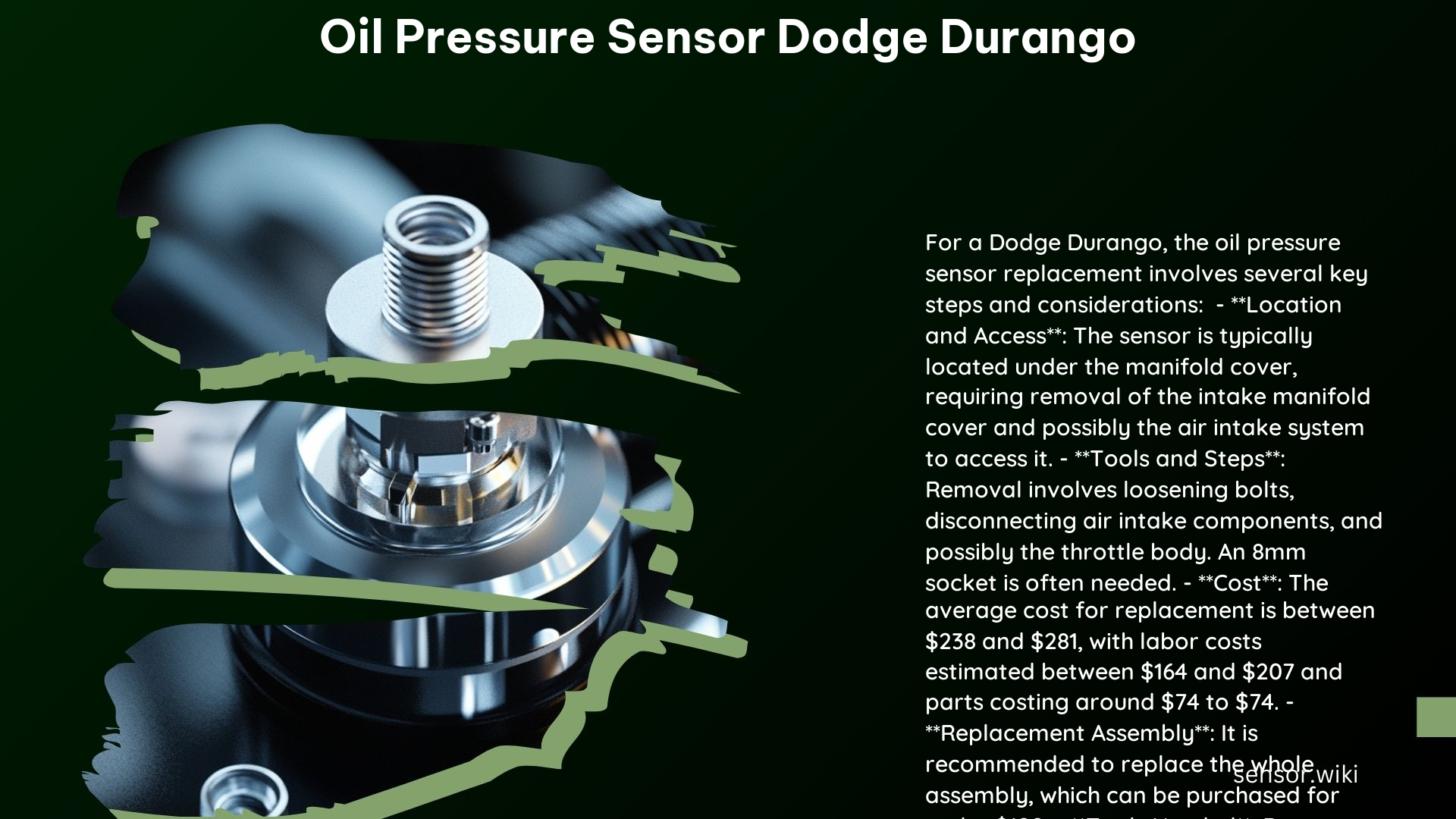The oil pressure sensor in the Dodge Durango is a critical component that monitors the engine’s oil pressure and relays this information to the vehicle’s computer. This article will provide a comprehensive guide on the oil pressure sensor, including its detailed specifications, step-by-step replacement instructions, common issues, and relevant troubleshooting techniques.
What are the Detailed Specifications and Functions of the Oil Pressure Sensor for the 2013 Dodge Durango?
The oil pressure sensor in the 2013 Dodge Durango with a 3.6L V6 engine has the following specifications:
Specifications:
– Type: Oil Pressure Sender/Switch
– Engine: 3.6L V6
– Material: Metal, Plastic
– Connector Gender: Female
– Terminal Quantity: 3
– Terminal Gender: Male
– Location: The oil pressure sensor is typically located near the engine block, often on the driver’s side. It is connected to the engine’s oil system and monitors the oil pressure.
Functions:
– The oil pressure sensor monitors the engine’s oil pressure and sends this information to the vehicle’s computer (ECU).
– It helps in maintaining optimal engine performance and alerts the driver if the oil pressure falls below a safe level.
– The sensor is crucial for preventing engine damage due to low oil pressure.
How to Replace the Oil Pressure Sensor in a 2013 Dodge Durango?

Replacing the oil pressure sensor in a 2013 Dodge Durango can be done with the following step-by-step instructions:
Tools Needed:
– 8mm socket (deep socket recommended)
– Flathead screwdriver
– Pick tool
– Crescent wrench (optional)
– New oil pressure sensor
Estimated Time for Replacement:
– Approximately 1-2 hours, depending on mechanical aptitude and accessibility.
Step-by-Step Instructions:
1. Remove the air intake.
2. Disconnect the mass airflow sensor or air temperature sensor.
3. Remove the throttle body.
4. Access the oil pressure sensor.
5. Remove the oil pressure sensor.
6. Install the new oil pressure sensor.
Safety Precautions:
– Ensure the engine is cool before starting the replacement.
– Use proper tools to avoid damaging components.
– Consult a repair manual or professional if unsure about any steps.
What are the Common Issues Associated with the Oil Pressure Switch in the 2014 Dodge Durango Limited?
The common issues associated with the oil pressure switch in the 2014 Dodge Durango Limited include:
Symptoms:
– Service engine light on
– Error codes related to oil pressure sensor (e.g., P0520: Engine Oil Pressure Sensor/Switch Circuit)
– Erratic or low oil pressure readings
– Engine performance issues due to incorrect oil pressure readings.
Diagnostic Procedures:
1. Check error codes.
2. Inspect the sensor and wiring.
3. Test the sensor.
Potential Solutions:
1. Replace the oil pressure sensor.
2. Repair or replace the wiring.
3. Consult a professional mechanic.
What are the Technical Details Regarding the Oil Pressure Sensor for the 2016 Dodge Durango?
The oil pressure sensor for the 2016 Dodge Durango with a 3.6L V6 engine is generally compatible with the previous model years. Here are the key details:
Compatibility:
– The oil pressure sensor for the 2016 Dodge Durango is generally compatible with the 3.6L V6 engine, similar to the 2013 model.
Part Numbers:
– Part numbers may vary depending on the supplier, but ensure the part is specified for the 3.6L V6 engine.
Installation Tips:
– Follow the same steps as for the 2013 model, ensuring all connections are secure and the sensor is properly seated.
– Consult the vehicle’s repair manual or a professional if there are any specific differences in the 2016 model.
What are the Relevant Troubleshooting Techniques for Diagnosing Oil Pressure Sensor Problems in the Dodge Durango?
When diagnosing oil pressure sensor problems in the Dodge Durango, the following troubleshooting techniques can be helpful:
Common Error Codes:
– P0520: Engine Oil Pressure Sensor/Switch Circuit
– P0521: Engine Oil Pressure Sensor/Switch Range/Performance Problem
– P0522: Engine Oil Pressure Sensor/Switch Low Voltage
– P0523: Engine Oil Pressure Sensor/Switch High Voltage.
Troubleshooting Techniques:
1. Check the sensor output using a multimeter.
2. Inspect the wiring and connections for any signs of damage or corrosion.
3. Test the sensor with a scan tool to monitor its output in real-time.
4. Consult the vehicle’s repair manual for specific troubleshooting procedures.
Reference:
1. 2013 Durango crew 3.6L Oil Pressure Sensor
2. How to: Replace 2013 Dodge Durango Oil Pressure Switch Sensor
3. Oil Pressure Sender/Switch for 2013 Dodge Durango 3.6L V6
